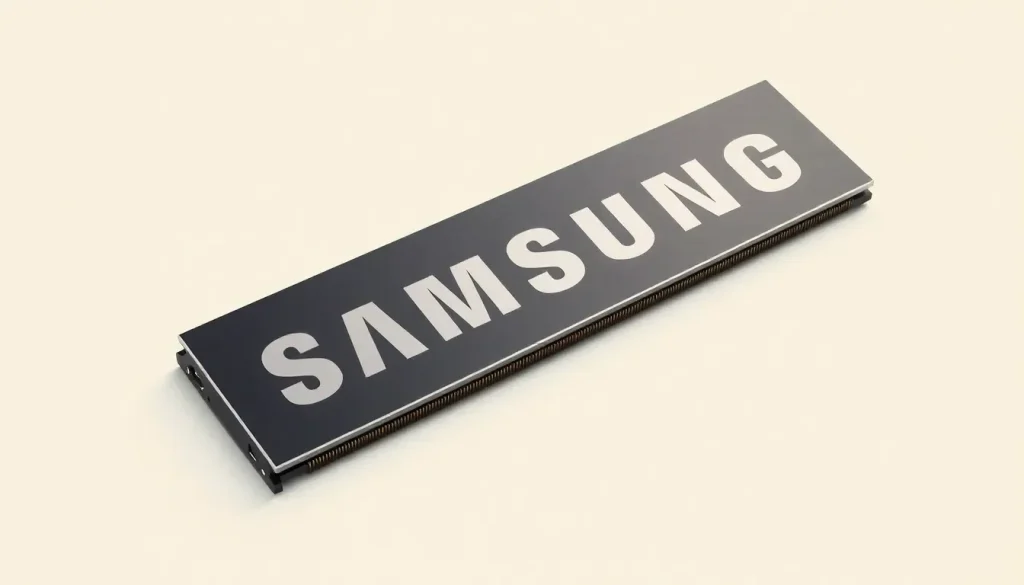Samsung competes for future memory leadership in AI GPU tech

As the tech industry rapidly evolves, the demand for advanced memory solutions becomes increasingly critical. Samsung is gearing up to make a significant leap in memory technology, drawing lessons from its past experiences with High Bandwidth Memory (HBM). In this dynamic landscape, the South Korean giant is investing heavily in developing what is being dubbed the "second era of high bandwidth memory", known as High Bandwidth Flash (HBF). This new memory type aims to enhance the capabilities of Artificial Intelligence (AI) GPUs, promising a combination of higher capacity and speed that could fundamentally transform the design of massive data accelerators. Samsung is determined not to miss out on the potential of HBF in this competitive market.
The intention is crystal clear: Samsung plans to position its memory chips at the heart of AI GPUs, especially those produced by NVIDIA and AMD, who are currently locked in fierce competition and will only intensify their efforts in the upcoming generation of technology.
Samsung's Bold Move Towards High Bandwidth Flash Memory
Samsung's foray into HBF is not just a simple upgrade; it's a strategic initiative to reclaim its leadership position in the memory market, especially in light of competition from SK Hynix. The HBF technology leverages the same vertical interconnection concept through Through Silicon Via (TSV) that HBM uses, but it applies this method to NAND memory. This innovative approach allows for significantly greater bandwidth and capacity.
One of the critical challenges that HBM faces is its physical density limit, which creates a bottleneck in performance. The HBF aims to address this issue effectively, enabling a new level of efficiency and speed in data processing. Additionally, this development would also stimulate advancements in traditional NAND Flash technologies, like those found in Solid State Drives (SSDs).
Samsung's objective is straightforward yet powerful: to position HBF modules alongside HBM within AI accelerators. This dual approach allows HBM to handle high-speed operations while HBF serves as a rapidly accessible intermediate storage for large data volumes. This combination could lay the groundwork for the next generation of GPUs, especially with the rise of multimodal models that simultaneously process text, images, and video.
The Growing Demands on AI GPUs
The underlying reasons for Samsung's strategic pivot towards HBF are clear. AI models like ChatGPT and Gemini have evolved to not only process language but also generate images and videos. This evolution dramatically increases the data volume that GPUs must handle, making speed and capacity paramount.
As the industry grapples with these challenges, it’s becoming evident that relying solely on HBM will not suffice. Competitors like SK Hynix and Kioxia have already begun to stake their claims in this emerging space. SK Hynix is collaborating with SanDisk to establish a joint HBF standard, with plans to showcase samples by 2026 and begin full production in 2027. Meanwhile, Kioxia recently unveiled a prototype boasting 5 TB capacity and high speeds, signaling the start of a competitive race reminiscent of the HBM battles of previous years.
Market Dynamics and Samsung's Strategic Position
The entry of Samsung into the HBF domain could mark a significant shift in the balance of power within the memory industry. According to TrendForce, Samsung currently holds a commanding 32.9% of the global NAND Flash market. This dominance, coupled with its expertise in stacked memory technology and large-scale production capabilities, positions the company to potentially reshape the market landscape.
- Samsung’s focus on HBF aims to enhance GPU performance.
- Utilizing TSV technology for increased bandwidth.
- The strategic importance of combining HBF with existing HBM memory.
- Impacts on traditional NAND Flash markets and competition.
As Samsung develops the conceptual designs for HBF, it is also likely to leverage its vast experience in memory production to streamline the manufacturing process. This could lead to faster deployment and integration of HBF into existing and future AI architectures.
Future Prospects and Innovations in Memory Technology
Looking ahead, the implications of HBF technology extend beyond just the immediate performance benefits for GPUs. As AI continues to evolve, memory technology will need to keep pace with the increasing complexity and capabilities of AI models. The integration of HBF could pave the way for:
- Enhanced processing speeds, allowing for real-time data analysis.
- Increased memory capacity, enabling larger and more complex models.
- Improved energy efficiency, critical for large data centers.
The demand for such innovations is echoed in the broader tech community. As more companies and research institutions invest in AI, the need for robust, high-performance memory solutions will only grow. Samsung’s proactive stance in developing HBF could not only secure its position in the market but also drive forward the entire field of AI technology.
For those interested in the future of AI and memory technologies, the following video provides insights into Samsung's vision and its impact on the digital landscape:
In conclusion, Samsung’s ambition to pioneer High Bandwidth Flash memory represents a significant advancement in the technology landscape, aligning with the growing needs of AI applications. As the competition heats up among memory manufacturers, the industry eagerly anticipates how these innovations will shape the future of computing.




Leave a Reply